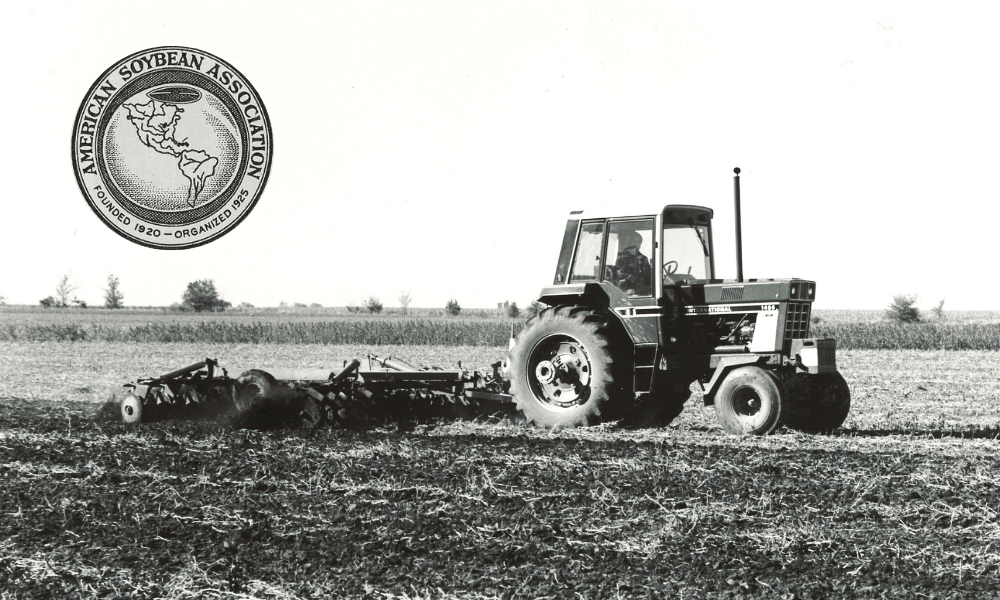
The American Soybean Association was founded in 1920 by farmers for farmers. (Submitted photo)
Soy Centennial: ASA celebrates 100 years
October 12, 2020
Meeting the demands of a growing world population is no small feat. Soybean farmers know that from firsthand experience. So does the organization that has supported them for 100 years, the American Soybean Association (ASA).
Planting the Seeds
The seeds of ASA were planted in September 1920, when 1,000 farmers and researchers gathered at Soyland Farms in Indiana. After discussing the many opportunities growing soybeans afforded farmers, there was a consensus that a dedicated organization was needed to help promote and develop soybean production and utilization in the U.S. And so, the National Soybean Growers’ Association was founded.
Just five years later, the organization had grown, prompting its leaders to adopt a constitution and bylaws and rebrand as American Soybean Association. It also adopted the measure to require membership fees to begin funding the efforts of maintaining satisfactory markets and eventually tackling 1931, the first major export of U.S. soybeans saw 2 million bushels exported to Europe. By 1937, sufficient amounts of soybeans were being raised and made available in commercial markets to justify the inauguration of trading in future soybean contracts by the Chicago Board of Trade — the first crop to be added in a very long time.
Taking Root in Iowa
While the seeds of ASA were planted in Indiana, the roots of the organization took hold in Iowa. The “little bean” was threatening to challenge “King Corn” for acreage. In 1940, the farmer leaders determined the organization needed full-time management.
ASA hired George Strayer, a 29-year-old Iowa soybean farmer, as executive secretary and the first paid employee. This effectively made Hudson, Iowa, the headquarters of ASA. The organization also established a formal board of directors that year.
Farmers involved in the organization went to work expanding awareness and markets for soybeans. Throughout the 1940s, they realized financing ASA solely through membership dues would not reliably support the broad scope of important activities the association needed to perform.
A voluntary nationwide investment program was launched in 1948, asking growers to invest one-fifth of one cent per bushel from the sale of their crop that year. Elevators were asked to sign an agreement with ASA to collect the money at the time of purchase and remit it to ASA. This program eventually led to the establishment of state soybean checkoff programs.
Growing Markets and Uses
The organization continued to grow, hitting new milestones along the way. ASA opened its first international office in Japan in 1956.
ASA worked diligently to develop international markets and was recognized with the “Billion Dollar Export” award by U.S. Secretary of Agriculture in 1966. Just two years later, and with a decade of work developing international markets under its belt, more than half of the U.S. soybean crop for that marketing year was exported.
While Minnesota was the first to organize a state soybean association in 1962, Iowa was not far behind. The Iowa Soybean Promotion Board was created (re-organized into the Iowa Soybean Association) two years later.
Harvesting Checkoff Dollars
After nearly 40 years of officing in Iowa, ASA moved to its “world” headquarters in St. Louis, Missouri, in 1989. At the same time, ASA began efforts to achieve a national soybean checkoff program. The Soybean Promotion, Research, and Consumer Information Act of 1991 was authorized by Congress as part of the 1990 Farm Bill and collections began.
One-half of one percent of the market price per bushel of soybeans sold are collected at the point of sale. The proceeds are split equally between state soybean checkoff and the national checkoff. A new farmer-led entity, the United Soybean Board, was created by the U.S. Department of Agriculture to oversee the investment of these dollars in non-policy-related areas.
With the soybean checkoff secured, ASA focused on supporting domestic and international policy issues. Today, ASA has 26 affiliated state associations representing 30 soybean-producing states and more than 300,000 soybean farmers.
Celebrating a Century
On August 4, 2020, ASA’s past and current leaders gathered at the association’s birthplace to celebrate.
ISA member Ray Gaesser of Corning attended the celebration held at the Fouts brothers’ Soyland farm in Camden, Indiana. It allowed him to reflect on his time serving as ASA president from 2013-2014 while also looking to the future.
“You’re not only making a difference for your fellow farmers, you’re making a difference for your family, too,” he says of being involved in ASA. “As you influence policies, you’re impacting things that have a direct impact on your farm and livelihood.”
Though many things have changed over the years, Gaesser says one thing has not — ASA is an organization founded by farmers for farmers. Looking ahead, he says there will always be public policy work that needs attention.
“That is really the charge of ASA,” he says. “The organization does policy work that helps farmers and protects them from legislation that may be detrimental to how we care for the land or our ability to operate. That work will always be important.”
This story was originally published in the October 2020 issue of the Iowa Soybean Review. The American Soybean Association contributed to this report.
Back